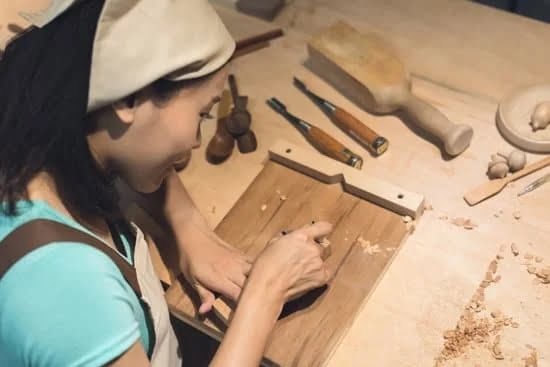Maintaining clean and well-maintained painted woodwork is crucial for enhancing the aesthetic appeal of any space. However, cleaning painted woodwork can present its fair share of challenges and common issues. That’s where the efficacy of using Castile soap comes in.
Painted woodwork, whether it be trim, cabinets, or furniture, can accumulate dirt, dust, fingerprints, and other stains over time. Neglecting regular cleaning can not only lead to a dull appearance but also cause permanent damage to the paint job. Therefore, understanding proper cleaning techniques becomes essential.
Castile soap is a mild yet effective solution for cleaning painted wood surfaces. Derived from vegetable oils such as olive oil or coconut oil, Castile soap is known for its gentle cleansing properties. In this article, we will delve into the importance of maintaining clean painted woodwork and discuss how Castile soap can help achieve remarkable results. So let’s explore the world of Castile soap and discover how it can breathe new life into your painted woodwork.
Preparing the Cleaning Solution
Identifying the right type of Castile soap for cleaning painted woodwork
When it comes to cleaning painted woodwork, not all Castile soaps are created equal. It is important to choose a Castile soap that is gentle and non-abrasive to ensure it does not damage the delicate surface of the paint.
Look for a Castile soap that is specifically labeled as suitable for cleaning purposes. Some popular brands offer different variations of Castile soap, such as lavender-scented or citrus-infused, but it is important to prioritize the soap’s effectiveness rather than its scent.
Step-by-step guide on how to create a highly effective cleaning solution using Castile soap
Creating a cleaning solution with Castile soap is a simple and straightforward process. Start by filling a bucket or container with warm water, leaving enough space for adding the Castile soap. The recommended ratio of water to Castile soap is approximately one tablespoon of soap per gallon of water. However, this ratio can be adjusted based on the level of dirt and grime on your painted woodwork.
Next, carefully pour the appropriate amount of Castile soap into the warm water and mix it gently until it dissolves completely. Avoid shaking or stirring vigorously, as this can create excessive suds. It is essential to dissolve the soap thoroughly to prevent any residue from being left behind on your painted wood surfaces.
Detailed instructions on the appropriate water-to-Castile soap ratio for optimal results
Achieving optimal results when mixing a Castile soap solution requires finding the right balance between cleanliness and gentleness. As previously mentioned, starting with approximately one tablespoon of Castile soap per gallon of warm water provides an effective ratio for regular cleaning purposes. However, if you are dealing with particularly stubborn stains or heavy grime buildup, you can increase the concentration by adding more Castile soap to the solution.
Remember that using too much soap can leave behind residue, which may require additional rinsing and wiping. On the other hand, using too little soap may result in an insufficient cleaning effect. It is recommended to start with the suggested ratio and adjust as needed based on your specific cleaning requirements. Regularly evaluate the cleanliness of your painted woodwork during the cleaning process to ensure you have achieved satisfactory results while avoiding any potential damage to the paint.
Gathering the Essential Tools
To effectively clean painted woodwork with castile soap, it is important to gather the necessary tools and supplies. Having the right equipment ensures that the cleaning process is efficient and minimizes the risk of damage to the painted surface. Here is a comprehensive list of must-have supplies for cleaning painted woodwork:
- Non-abrasive cleaning cloths: Opt for soft and lint-free cloths that won’t scratch or leave residue on the painted surface. Microfiber cloths are highly recommended due to their gentle yet effective cleaning properties.
- Soft-bristle brushes: Use soft-bristle brushes to remove dust and dirt from intricate areas such as crevices and corners. These brushes should be gentle enough to avoid scratching or damaging the painted surface.
- Bucket or container: A bucket or container is essential for mixing the Castile soap solution and dipping your cleaning cloth or brush into it.
- Castile soap: Choose a mild and natural liquid Castile soap specifically designed for cleaning purposes. Avoid using soaps that contain harsh chemicals or additives that can potentially damage the paint.
- Water: Use clean, lukewarm water to create the cleaning solution with Castile soap.
- Optional: Additional equipment such as a spray bottle may be useful for applying the diluted Castile soap solution onto larger surfaces.
When gathering these supplies, it’s worth considering eco-friendly alternatives to disposable cleaning wipes or chemical-laden cleaners. By opting for reusable microfiber cloths and natural Castile soap, not only will you achieve effective results in cleaning your painted woodwork, but you will also contribute to a more sustainable environment.
| Supplies |
|---|
| Non-abrasive cleaning cloths |
| Soft-bristle brushes |
| Bucket or container |
| Castile soap |
| Water |
| Optional: Spray bottle |
Basic Cleaning Techniques
Understanding the Importance of Regular Dusting and Cleaning
Regular cleaning and dusting of painted woodwork is essential for maintaining its longevity and aesthetic appeal. Dust, dirt, and grime can accumulate on painted wood surfaces over time, causing them to appear dull and unclean. Additionally, neglecting regular cleaning can lead to the build-up of stubborn stains that are more challenging to remove.
To prevent this, it is important to incorporate regular dusting into your cleaning routine. Use a soft-bristle brush or a microfiber cloth to gently remove dust from the surface of the painted woodwork. Start from the top and work your way down to ensure that all areas are covered. Avoid using rough materials or abrasive cleaners as they can cause damage to the painted surface.
Using Castile Soap Solution for Gentle Yet Deep Cleaning
For deeper cleaning, Castile soap solution is highly effective in removing dirt and grime from painted woodwork without causing any damage. Castile soap is a gentle cleanser made from plant-based oils such as olive oil or coconut oil, making it safe for use on various surfaces including painted wood.
To create a Castile soap solution for cleaning painted woodwork, follow these steps:
- Fill a bucket or container with warm water.
- Add a few drops of Castile soap.
- Mix well until the soap has dissolved completely.
Remember that using too much soap can leave behind residue, so it’s important to find the right balance. You can adjust the amount of Castile soap according to how dirty your painted woodwork is. It’s always better to start with less soap and add more if needed.
With your Castile soap solution ready, dip a non-abrasive cleaning cloth or sponge into the mixture and wring out any excess water. Gently wipe down all surfaces of the painted woodwork, paying extra attention to areas with dirt and grime buildup. Rinse the cleaning cloth or sponge frequently during the cleaning process to avoid spreading dirt around.
Tips for Efficiently Removing Dirt, Fingerprints, and Common Stains
In addition to general dusting and cleaning, there are specific techniques that can be used to address common stains found on painted woodwork. Here are some tips for efficiently removing dirt, fingerprints, and other common stains:
- For dirt and dust: Use a slightly dampened microfiber cloth or a soft-bristle brush to gently remove the loose debris from the surface of the painted woodwork.
- For fingerprints: Moisten a non-abrasive cleaning cloth with your Castile soap solution and gently wipe away the fingerprints using circular motions.
- For other stains: Apply a small amount of Castile soap directly onto the stain and gently rub it with a soft-bristle brush in a circular motion. Rinse the area with water and wipe dry.
It’s important to always test any cleaning solution or technique on an inconspicuous area of the painted woodwork before applying it to the entire surface. This will help ensure that no damage or discoloration occurs.
Overall, by incorporating regular cleaning techniques and using Castile soap solution, you can effectively remove dust, dirt, and grime from painted woodwork while preserving its beauty and longevity.
Basic Cleaning Techniques: Removing Dust, Dirt, and Grime from Painted Woodwork
| Technique | Description |
|---|---|
| Regular Dusting | Use a soft-bristle brush or microfiber cloth to gently remove dust from painted wood surfaces. |
| Castile Soap Solution | Create a solution using warm water and Castile soap for deeper cleaning of dirt and grime on painted woodwork. |
| Fingerprints | Moisten a non-abrasive cloth with Castile soap solution to gently wipe away fingerprints using circular motions. |
| Other Stains | Apply a small amount of Castile soap directly onto the stain and gently rub with a soft-bristle brush in circular motions. Rinse and wipe dry. |
Tackling Stubborn Stains
Stubborn stains can be a common issue when it comes to painted woodwork. Whether it’s water stains, grease spots, or the marks left by crayons, these stains can be a real headache to remove. However, with the right techniques and the use of Castile soap, you can effectively tackle these difficult marks and restore the beauty of your painted woodwork.
To begin with, it’s important to identify the type of stain you’re dealing with. Water stains are often caused by moisture penetrating the surface of the paint, leaving behind unsightly discoloration. Grease spots are typically caused by oily substances and can leave a residue on the painted surface. Crayon marks are common in households with children and can be challenging to remove without damaging the paint.
For water stains, start by mixing a solution of Castile soap and warm water in a bucket or spray bottle. Apply the solution directly to the stained area using a soft cloth or sponge. Gently rub the stain in circular motions until it begins to lift. Rinse the area thoroughly with clean water and dry it immediately to prevent further damage.
Grease spots may require a slightly different approach. Begin by sprinkling baking soda directly onto the stain and let it sit for a few minutes to absorb the grease. Then create a mixture of Castile soap and warm water and apply it to the stained area using a soft cloth or sponge. Gently scrub the stain until it is removed completely, then rinse with clean water.
Crayon marks can sometimes be more stubborn than other types of stains due to their wax-based nature. Start by applying heat directly to the crayon mark using a hairdryer on low heat or an iron on low temperature. This will soften the wax, making it easier to remove. Once softened, gently wipe away as much of the crayon mark as possible using a cloth dampened with Castile soap solution. Repeat if necessary until the mark is completely gone.
By following these specialized techniques and utilizing the power of Castile soap, you can effectively tackle difficult marks on painted woodwork. Remember to always test any cleaning solution or method in an inconspicuous area first to ensure it does not damage or discolor the paint. With a little patience and the right approach, you can restore your painted woodwork to its original beauty.
Restoring Luster and Shine
Maintaining the luster and shine of painted woodwork is essential to enhance the overall aesthetic appeal of any space. Over time, painted wood surfaces may become dull or lose their shine due to dust, dirt, and wear and tear.
Fortunately, Castile soap can be used as a non-toxic and effective polish for painted wood surfaces. In this section, we will explore the importance of restoring luster and shine to painted woodwork and provide step-by-step instructions on using Castile soap for this purpose.
Importance of Restoring Luster and Shine
Painted woodwork that has lost its luster can make a room appear dull and lackluster. Restoring the shine not only rejuvenates the appearance of the woodwork but also helps protect it from further damage. By polishing your painted wood surfaces regularly, you create a layer of protection against scratches, stains, and other damages caused by daily usage.
Using Castile Soap as a Non-Toxic Polish
Castile soap is an excellent choice for polishing painted woodwork because it is made from natural ingredients like olive oil or coconut oil. It does not contain harsh chemicals or synthetic additives that could potentially harm the paint finish or jeopardize the indoor air quality. Additionally, Castile soap’s gentle yet effective cleaning properties make it safe to use on delicate surfaces without causing any damage.
Step-by-Step Instructions for Polishing with Castile Soap
- Prepare a cleaning solution: Mix a small amount of Castile soap with warm water in a bucket or spray bottle. The exact ratio will depend on the manufacturer’s instructions, but typically 1-2 tablespoons of Castile soap per gallon of water is sufficient.
- Test in an inconspicuous area: Before applying the solution to the entire surface, test it on a small inconspicuous area to ensure it does not cause any adverse effects on the paint or finish.
- Apply the solution: Dip a soft, non-abrasive cloth or sponge into the Castile soap solution and wring out any excess liquid. Gently wipe the painted woodwork in even strokes, following the direction of the grain.
- Remove excess moisture: After cleaning, use a clean, dry cloth to remove any remaining moisture from the surface. This will prevent water spots or streaks from forming as it dries.
Optional: Beeswax Polish
For an extra layer of protection and shine, you can further enhance the results by applying beeswax polish to your painted woodwork after cleaning with Castile soap. Simply melt a small amount of beeswax in a double boiler or microwave-safe container and allow it to cool slightly. Then, using a soft cloth or brush, apply a thin layer of melted beeswax onto the surface in circular motions. Buff gently to achieve a smooth and shiny finish.
By following these steps, you can restore luster and shine to your painted woodwork using Castile soap as an eco-friendly and non-toxic alternative to chemical-laden polishes. Regularly maintaining and polishing your painted wood surfaces will not only prolong their lifespan but also contribute to creating a beautiful and inviting atmosphere in your living spaces.
Maintaining Clean Painted Woodwork
Proper maintenance is key to ensuring clean and well-maintained painted woodwork that enhances the aesthetic appeal of any space. In this section, we will discuss the best practices and preventive measures for maintaining clean painted woodwork. By following these guidelines, you can prolong the lifespan of your painted wood surfaces and keep them looking their best.
- Regular Dusting: Regular dusting is essential for removing surface debris and preventing buildup. Use a non-abrasive microfiber cloth or a soft-bristle brush to gently remove dust from the painted woodwork. Avoid using rough materials or harsh chemicals that can damage the paint finish.
- Gentle Cleaning: When it comes to cleaning painted woodwork, it’s important to use gentle methods that won’t strip away the paint or cause any damage. The Castile soap solution that we discussed earlier is an ideal option for this purpose. Remember to follow the instructions provided in the previous section on preparing the cleaning solution.
- Avoid Harsh Cleaners and Abrasive Tools: Harsh chemical cleaners can be damaging to painted surfaces, as they may strip away the paint or cause discoloration. Similarly, abrasive tools such as scouring pads or rough brushes should be avoided, as they can scratch or scrape the paint finish. Stick to non-abrasive cleaning cloths and soft-bristle brushes for optimal results.
4. Preventing Future Stains and Damages: Taking preventive measures is key to maintaining clean painted woodwork in the long term. Here are some tips to help prevent future stains, scratches, and other damages:
- Use coasters or placemats under hot dishes, glasses, and other items to protect against heat marks and water rings.
- Place furniture pads on the bottom of chairs, tables, and other furniture to prevent scratching or denting.
- Avoid hanging wet or damp items directly on painted wood surfaces to prevent water damage.
- Consider applying a clear protective coat, such as polyurethane, to add an extra layer of protection to the paint finish.
By following these best practices and taking preventive measures, you can maintain clean and well-preserved painted woodwork in your space. Remember to embrace eco-friendly cleaning solutions like Castile soap for a more sustainable approach. With proper care and maintenance, your painted woodwork will continue to enhance the beauty of your home or any other environment for years to come.
Final Thoughts
In conclusion, incorporating Castile soap into your cleaning routine can offer numerous benefits when it comes to maintaining and enhancing the beauty of painted woodwork. Not only is Castile soap highly effective in removing dirt, grime, and stubborn stains, but it also provides a non-toxic and eco-friendly alternative to harsh chemical cleaners.
By following the step-by-step instructions outlined in this article, you can achieve remarkable results in restoring the luster and shine of your painted wood surfaces.
One of the key advantages of using Castile soap is its versatility. Whether you are dealing with everyday dust or tackling more challenging stains like water marks or grease spots, Castile soap proves to be an invaluable tool. Its gentle yet effective cleaning properties make it suitable for a wide range of painted wood surfaces, providing peace of mind knowing that your cherished furniture or trim will not be damaged during the cleaning process.
It is important to remember that proper maintenance is crucial for preserving the longevity and aesthetic appeal of your painted woodwork. By regularly dusting and cleaning with Castile soap, you can prevent dirt buildup and scratches while maintaining a fresh appearance. Additionally, avoiding harsh cleaners and abrasive tools will minimize any potential damage to the paint finish. Embracing sustainable cleaning practices such as using Castile soap not only benefits your immediate surroundings but also contributes towards a greener future.
Frequently Asked Questions
Is castile soap safe on wood?
Castile soap is generally considered safe to use on wood surfaces. Its natural formula derived from vegetable oils makes it a gentle cleanser that won’t strip away the natural oils or finish of the wood.
However, it’s important to dilute the soap properly and test it on a small, inconspicuous area first before applying it to larger portions of the wood surface. This will help ensure that there are no adverse reactions or damage to the wood.
Can you use Dr Bronner’s soap on wood?
Yes, Dr Bronner’s soap can be used on wood surfaces as well. Dr Bronner’s castile soap is known for its versatility, and its gentle nature makes it suitable for cleaning various household items, including wood furniture or flooring.
As with any cleaning product, it’s still advisable to dilute the soap appropriately and test it on a small section of the wood surface beforehand to check if there are any negative effects.
Can you use castile soap on painted walls?
Using castile soap on painted walls should generally be safe, especially if the paint is durable and in good condition. However, just like with any other cleaning product, it is essential to dilute the castile soap properly and test it first on an inconspicuous spot of the painted wall before applying it more extensively.
Some paints may be more sensitive than others, especially matte or flat finishes, so extra caution should be exercised when using any cleaning solution on them.

Hi everyone! I’m a woodworker and blogger, and this is my woodworking blog. In my blog, I share tips and tricks for woodworkers of all skill levels, as well as project ideas that you can try yourself.





